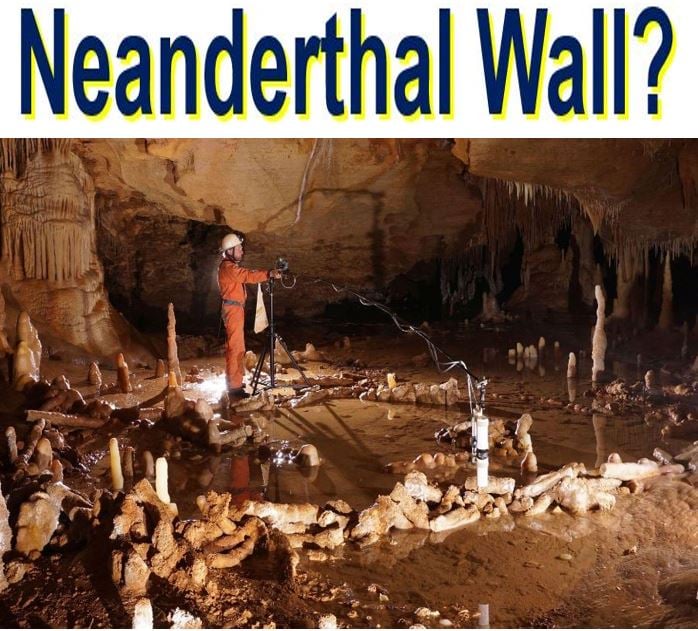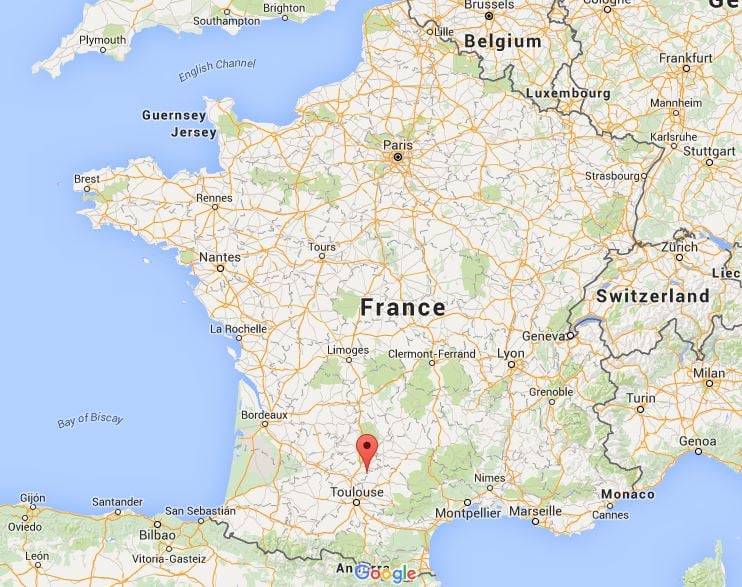Neanderthals were builders who constructed walls and ventured deep into caves, an international team of scientists have revealed after examining some 175,000-year-old semicircular walls of stalagmites one-third of a kilometre into a cave in southwest France.
The scientists, from France, Belgium, China, USA and Switzerland, explained in the prestigious journal Nature (citation below) that the walls are the best evidence that Neanderthals built considerable structures and ventured deep into the bowels of caves.
 According to the scientists: “This discovery proves that early Neanderthals were more advanced than previously assumed: they were well organized, mastered the use of fire and manipulated the deep karst environment.” (Image: naturalsciences.be)
According to the scientists: “This discovery proves that early Neanderthals were more advanced than previously assumed: they were well organized, mastered the use of fire and manipulated the deep karst environment.” (Image: naturalsciences.be)
Mystery – what were the walls for?
Ewen Callaway, writing in Nature News, quoted Jean-Jacques Hublin, a palaeoanthropologist at the Max Planck Institute for Evolutionary Anthropology in Leipzig, Germany, who was not involved in the study, as saying:
“The big question is why they made it. Some people will come up with interpretations of ritual or religion or symbolism. Why not? But how to prove it?”
Speleologists (they study caves) discovered the structures in the early 1990s in the Bruniquel Cave, in the Tarn-et-Garonne department, Midi-Pyrénées region in southern France. The walls are deep within the cave – one third of a kilometer from its entrance.
To get to the walls you have to go through a passage which narrows until you have to crawl on all fours.
 A 3D reconstruction of the structures in the Bruniquel Cave that scientists believe were made by Neanderthals 175,000 years ago. (Image: nature.com. Credit: Xavier MUTH)
A 3D reconstruction of the structures in the Bruniquel Cave that scientists believe were made by Neanderthals 175,000 years ago. (Image: nature.com. Credit: Xavier MUTH)
Later, a team of archaeologists found a burnt bone from a cave bear or herbivore nearby. Given that no radioactive carbon was left in it, it was over 50,000 years old. However, when the lead archaeologist of the excavation died in 1999, all work stopped.
A few years later, palaeoclimatologist Sophie Verheyden, from the Royal Belgian Institute of Natural Sciences in Brussels, and a keen speleologist started wondering about the cave after buying a holiday home in the area.
Dr. Verheyden got a team of geochronologists, archaeologists and other experts together to take a closer look at the enigmatic structures.
Six semicircular structures
The structures are made of approximately 400 big, broken-off stalagmites, arranged in semi-circles up to 22 feet (6.7 metres) wide.
Scientists believe that the pieces were once put up to form rudimentary walls. They also say fires were most likely made within the semicircles, because they all have signs of burning.
By analyzing the calcite that had accumulated on the stalagmites and stumps since they were broken off, the researchers dated the structures to between 174,400 and 178,600 years ago.
Geoscientist Dominique Genty, who works at the Institute Pierre-Simon Laplace in Gif-sur-Yvette, France, said: “It’s obvious when you see it, that it’s not natural.”
 Speleologists (cave experts) discovered the Bruniquel cave (in Tarn-et-Garonne) in the valley of Aveyron, southwest France, in 1990. (Image: Google Maps)
Speleologists (cave experts) discovered the Bruniquel cave (in Tarn-et-Garonne) in the valley of Aveyron, southwest France, in 1990. (Image: Google Maps)
There was no evidence that cave bears had hibernated near the walls, and so could have broken off the stalagmites. Even if they had, it is doubtful that a bear would have arranged them in such a geometrically precise manner.
Builders must have been Neanderthals
There were no hominins in Western Europe 174,000 years ago, so the authors believe the structures were built by Neanderthals. However, so far, no early-human remains, stone tools or any other signs of occupation have been found.
Nobody knows why the Neanderthals built the structures, that is of course, if Neanderthals really built them. Dr. Genty described the walls as “A big mystery.”
175,000yr-old #Neanderthal structures, 7m across x 0.4m high, found deep in Pyrenean cave https://t.co/uwJSgRQWwe pic.twitter.com/ztvlby6L3S
— Susan Oosthuizen (@DrSueOosthuizen) 25 May 2016
In an Article Preview, the authors wrote:
“Uranium-series dating of stalagmite regrowths on the structures and on burnt bone, combined with the dating of stalagmite tips in the structures, give a reliable and replicated age of 176.5 thousand years (±2.1 thousand years), making these edifices among the oldest known well-dated constructions made by humans.”
“Their presence at 336 metres from the entrance of the cave indicates that humans from this period had already mastered the underground environment, which can be considered a major step in human modernity.”
Citation: “Early Neanderthal constructions deep in Bruniquel Cave in southwestern France,” Hubert Camus, Serge Delaby, Damien Deldicque, Jacques Jaubert, Sophie Verheyden, Dominique Genty, Catherine Ferrier, Michel Soulier, Hai Cheng, Dominique Blamart, Christian Burlet, R. Lawrence Edwards, François Lacrampe-Cuyaubère, François Lévêque, Frédéric Maksud, Pascal Mora, Jean-Noël Rouzaud, Xavier Muth, Édouard Régnier & Frédéric Santos. Nature. 25 May 2016. DOI: 10.1038/nature18291.
Video – The Neanderthal sculpture garden
They are some of the oldest constructions made by humans we know of – lost for about 175,000 years, deep in a cave in France. Nobody knows why they were built, but their complexity gives us an insight into the skills of their creators.
Discover more from Market Business News
Subscribe to get the latest posts sent to your email.

